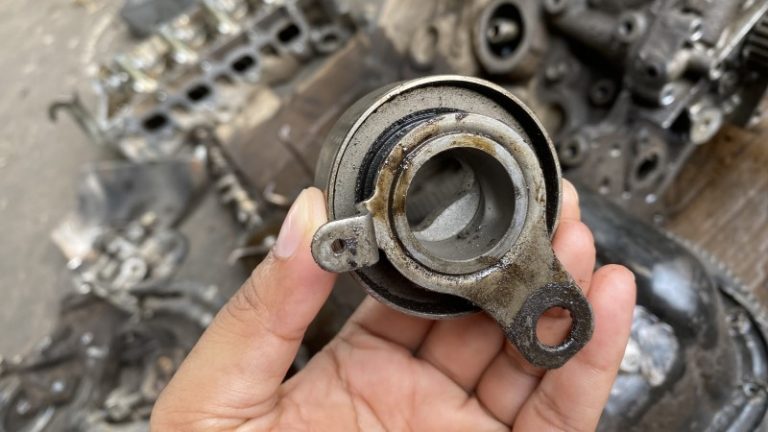The timing belt runs smoothly and undisturbed because the belt tensioner presses on it. But severe damage, such as engine failure, could result from a tensioner failure.
What is a Timing belt Tensioner, and how it works?
In the space between the alternator pulleys and the crankshaft you’ll find the timing belt tensioner. It keeps the timing belt taut and in good working order by applying pressure to it. The timing belt, which runs between the engine’s camshaft and crankshaft, is located in the engine’s front end.

An internal combustion engine’s rubber timing belt keeps the crankshaft and camshaft in sync. The belt’s job is to coordinate the engine’s valve opening and closing times with the piston’s precise location.
Furthermore, the engine’s internal combustion system is kept going by the timing belt. The crankshaft pulley and the camshaft pulley work together to accomplish this. If you accomplish this, the engine’s intake, compression, combustion, and exhaust systems will all work as they should.
A specific amount of pressure, maintained by maintaining the belt taut, is necessary for the timing belt to correctly grip the pulley and turn it. The tensioner is then activated.
Additional components of the belt tensioner include the base, the tensioner arm, the spring, and the pulley. The spring tightens the belts, and the base holds the other components of the belt. The belt will be able to travel much more easily with the help of the pulley. Then, to allow for belt adjustment or removal, the tensioner arm—visible at the tensioner’s base—works against the spring to provide sufficient slack.
A loose belt, caused by a malfunctioning belt tensioner, can have an impact on engine performance and, if left unchecked, lead to more serious problems. Another potential reason of a broken belt is a defective belt tensioner.
What are the Symptoms of a bad-timing belt tensioner?
There are a few telltale symptoms that indicate a timing belt tensioner is about to give out.
1. Engine performance issue
In order to ensure good ignition, the timing belt must open and close the valve at precise intervals. In the engine’s combustion system, you’ll find the intake valve, which, when opened, allows the air-fuel combination to be released.
The engine can’t run without the air-fuel mixture, which is why the valve must be open. Damage to the tensioner prevents the timing belt from operating as intended, which in turn causes the valve to remain either open or closed, depending on the direction of the damage. The engine’s performance will degrade after this.
2. Starting issue
During ignition, the fuel mixture is supplied to the engine by the valve. The timing belt might get loose or even break if the tensioner isn’t working properly. The gasoline mixture supply valve will stay closed in this case.

The igniting process will not occur after the valve is closed. This is due to the fact that the plug cannot light the fuel. This means that when you turn the key to start the engine, you could hear a cranking sound but no spark.
3. Timing belt tensioner noise
Damage to the tensioner can cause the timing belt to become loose or broken, the tensioner to have difficulty functioning, and other issues. A malfunctioning timing belt tensioner will make all of these things obvious.
As an example, the pulley could be affected if the timing belt were to break due to damage to the tensioner. The pulley will become stuck and make an annoying noise after this.
Does anyone know what the noise of a belt tensioner that isn’t ticking over is? There are a few possible sources of the noise.
- Knocking sound
- Rattling sound
- Squeaking or squealing sound
Which engine noises are audible depend on where the damage is located. Be on the lookout for the aforementioned engine noises and take swift action if you hear them.
4. Triggered engine light
The computer system of the engine constantly checks the engine’s operations to make sure it’s following the programed instructions. If there’s a problem with the tension belt, the engine won’t run as smoothly as it should, which will lead the computer to turn on the engine light.
Furthermore, when the engine light comes on, it alerts the driver that there is an issue with the engine system. Pay attention to the light.
5. Issues accelerating
Also, you’ll see that the car is slow to accelerate, even when you press down on the accelerator pedal. The timing belt tensioner is damaged, which means the engine isn’t getting adequate fuel mixture.
The engine’s power production will be negatively impacted because the intake valve will no longer open and close at the correct times.
Conclusion
Investigate the source of any unusual engine noises as soon as you hear them. A broken timing belt tensioner can be the source of the noise. In this case, you might want to look at the tensioner and timing belt. It is possible to have a specialist assess the problem and make the necessary repairs if you do not possess the necessary mechanical expertise.





